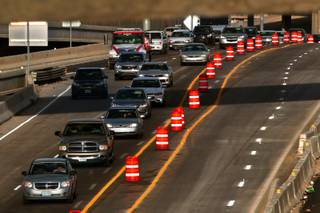
Traffic flows smoothly on the first morning of The Big Squeeze lane closures related to Project Neon, a $1 billion 3.7-mile-long widening of Interstate 15 from the U.S. 95 interchange to Sahara Avenue on Tuesday, March 21, 2017.
Saturday, July 22, 2017 | 2 a.m.
The most expensive public works project in Nevada’s history, underway for one year, marked 40 percent completion this week.
Project Neon, the $1 billion 3.7-mile-long widening of Interstate 15 between the Spaghetti Bowl and Sahara Avenue, improves the busiest stretch of highway in the state. It sees 300,000 vehicles daily, or 10 percent of the state population, with 25,000 lane changes per hour.
“Project Neon is nearly 40 percent complete, recording roughly 400,000 man-hours of work thus far without a recordable injury,” said Dale Keller, Nevada Department of Transportation project manager. “Meanwhile, the transformation of Martin Luther King Boulevard into an enhanced feeder-like roadway paralleling Interstate 15 is nearly complete.”
NDOT expects traffic through the corridor to double by 2035.
Construction has included:
• More than one mile of reinforced concrete box culvert for flood control.
• The longest sign structure in the state — an automated traffic management sign, which measures 12.5-feet-tall by 77-feet-wide or about the size of video billboards common in stadiums.
• 46 girders set, including the longest precast girders in the state (168 feet long).
• 607 tons of reinforcing steel — more than five times the steel used in the Statue of Liberty.
• 6,342 cubic yards of concrete — enough to pave a 12-foot lane of concrete, 1-foot thick for 2.5 miles.
• 43 structures demolished.
• More than 17 miles of utilities installed.
Project Neon is divided into three major phases: “Car-nado,” which took place from the end of October 2016 through February on I-15 near the Spaghetti Bowl; “The Big Squeeze,” which began in March and will run through early 2018 on U.S. 95 from Rancho Drive to the Spaghetti Bowl; and the third yet-to-be-named phase which will run from the spring until the project’s completion in 2019 and include work on I-15 from the Spaghetti Bowl to Sahara Avenue.
Within the “The Big Squeeze” is the centerpiece of Project Neon, an 81-foot-tall, 2,606-foot-long High Occupancy Vehicle (HOV) flyover bridge from southbound U.S. 95 to southbound I-15 that also accommodates northbound carpool traffic.
The project also merges the two existing I-15 express lanes into a general-purpose and HOV lane. By doing so NDOT is creating 22 consecutive miles of carpool lanes from I-15 at Tropicana Avenue to U.S. 95. at Ann Road.
The HOV lanes allow carpoolers and rapid transit downtown Las Vegas access with the Neon Gateway interchange between Charleston Boulevard and Oakey Avenue.
Additionally, a full-diamond interchange at Charleston Boulevard will allow easier access to downtown, the Medical District on Shadow Lane and Symphony Park, and several “ramp braids” will reduce merge and weave traffic on I-15.
Aesthetic and landscape upgrades, dynamic message signs and improved drainage are among other improvements associated with the project.
“People are slowing down and proceeding with caution through construction work zones, re-acclimating themselves to lane changes,” NDOT spokesman Tony Illia said. “Additionally, speeding fines are double in active construction work zones.”
Kiewit Infrastructure West Co., the general contractor on Project Neon, is under a $559 million design-build contract, with Atkins North America the lead designer. The project has created 4,000 local jobs as well as other opportunities for federally certified minority- and women-owned businesses, according to an NDOT news release.
“Project Neon, upon completion in summer 2019, will reduce travel delays by 28 percent for a $110 million annual savings through increased productivity,” NDOT Director Rudy Malfabon said. “It will also improve air quality due to less idle time and vehicle exhaust while enhancing motorist safety from reduced merge and weave traffic.”
Another benefit: FBI and SWAT used buildings that NDOT acquired through the right-of-way process for two weeks of training.
“Law enforcement practiced breaching techniques, among other things,” Illia said. “It gave them real-world experience, smashing through walls and doors, while also field-testing specialized incursion equipment.”
For more information on Project Neon, check the project's website, Twitter page @NDOTProjectNeon or the smartphone and tablet app for up-to-date information. Motorists can also call the Project Neon hotline available in both English and Spanish at 702-293-6366.


Join the Discussion:
Check this out for a full explanation of our conversion to the LiveFyre commenting system and instructions on how to sign up for an account.
Full comments policy